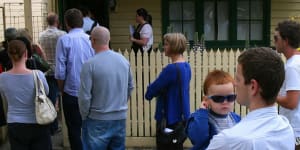Experts say other interim measures,such as rent caps and slowing immigration,are needed until more homes are built to ease pressure on renters.

Asking rents for houses and units far outpaced wage growth in an ongoing deterioration of affordability.Craig Sillitoe
Asking rents for houses rose by more than six times the rate of wages in the March quarter,a comparison of the Australian Bureau of Statistics (ABS) wage price index with Domain rent data showed.
Wages ticked up by 0.8 per cent,while combined capital city asking rents for houses jumped 5 per cent. Meanwhile,unit rents increased by more than four times the rate of wages,growing 3.3 per cent across all capitals for the quarter.
It continued a four-year streak of rents rising far above wages,an unprecedented run in recent history,Ray White chief economist Nerida Conisbee said.
“Rents were very affordable in Australia up until about 2020. They pretty much didn’t move for about 10 years. So people’s wages would have increased,but the rent didn’t,” Conisbee said. “We’ve seen a rapid increase in rents pretty much since the start of the pandemic.”
She said a major reason was people seeking more space by moving out of share houses in favour of living alone,or needing more rooms for home offices.
“Every household size shrunk – and that was fine while we weren’t having any migration and hardly any population growth. But that obviously changed when we got back to more normal levels of migration,and at the same time,we had a construction crisis,” she said. “It’s been a really challenging time for the housing market.”
The federal government’s target of building 1.2 million homes by 2029 will not solve the problem in the short term,she warned.
Grattan Institute economist Joey Moloney agreed that though building more homes was important,it would not do anything for people suffering rental stress today.

Experts say interim measures are needed to ease the pressure on renters until more homes are built.Ben Rushton
“The single most important lever the federal government can pull is to keep increasing rent assistance for the most vulnerable people,” Moloney said.
“Globally,we don’t have high rates of homelessness,but if rents remain high,there is no doubt we will see more homelessness.”
Historic underinvestment in social housing was another factor putting more people at risk of becoming homeless,and governments needed to ensure more of it was available,he said.
‘This takes the pressure off’
There was also some merit in limiting how many rent increases landlords are allowed to pass on to tenants,he said,something all states do in different ways.
The ACT has arguably the most robust regulations:landlords there can only raise rents by 10 per cent more than the current inflation rate of rents in Canberra,and only once every 12 months.
Moloney said it was better for tenants than in other states,where the tenant often had to appeal against a rent increase to the civil and administrative tribunal,which he described as a daunting process.
“This takes the pressure off the tenant,as it gives an external benchmark for how much of an increase is allowed. If a landlord wants to increase the rent by more than that,they need to prove there is a legitimate reason.”
However,that regulation was unlikely to work in other states,he said,as the ABS only measures the Consumer Price Index for rents in capital cities,not regional areas,of which there are none in the ACT,as the whole state is considered as Canberra.
Moloney said slowing immigration rates,limiting international students,and people starting to move back into share houses would all help to improve the situation for renters.
“But can we get back to a period of rental growth being the same as inflation? That depends on the construction of new housing,” Moloney said.
Fundamental problem
Conisbee said that was a challenge not just because of labour shortages but also because of taxes and regulations,which made it more expensive to invest in new housing,particularly in inner-city areas.
“Look at somewhere like Collingwood in Melbourne. So Collingwood is really cool,a great place for young people,and it’s got a lot of apartments. It’s been very affordable and so affordable even now you can buy a two-bedroom apartment,pretty new for about $600,000 to $650,000.” she said.
“But developers are now saying you couldn’t build for $650,000 any more in Collingwood,and it’s likely that trying to build something similar would probably cost $800,000 to $900,000. So that’s fundamentally the problem,” she said.
Despite this,she said rents would eventually come back into line with wages,but it would take far longer than desired.
In a sign of how long it may take to ameliorate rental stress,capital city asking rents fell 0.5 per cent to June 4,the first material monthly decline since April 2020,separate data released by SQM Research on Wednesday revealed.